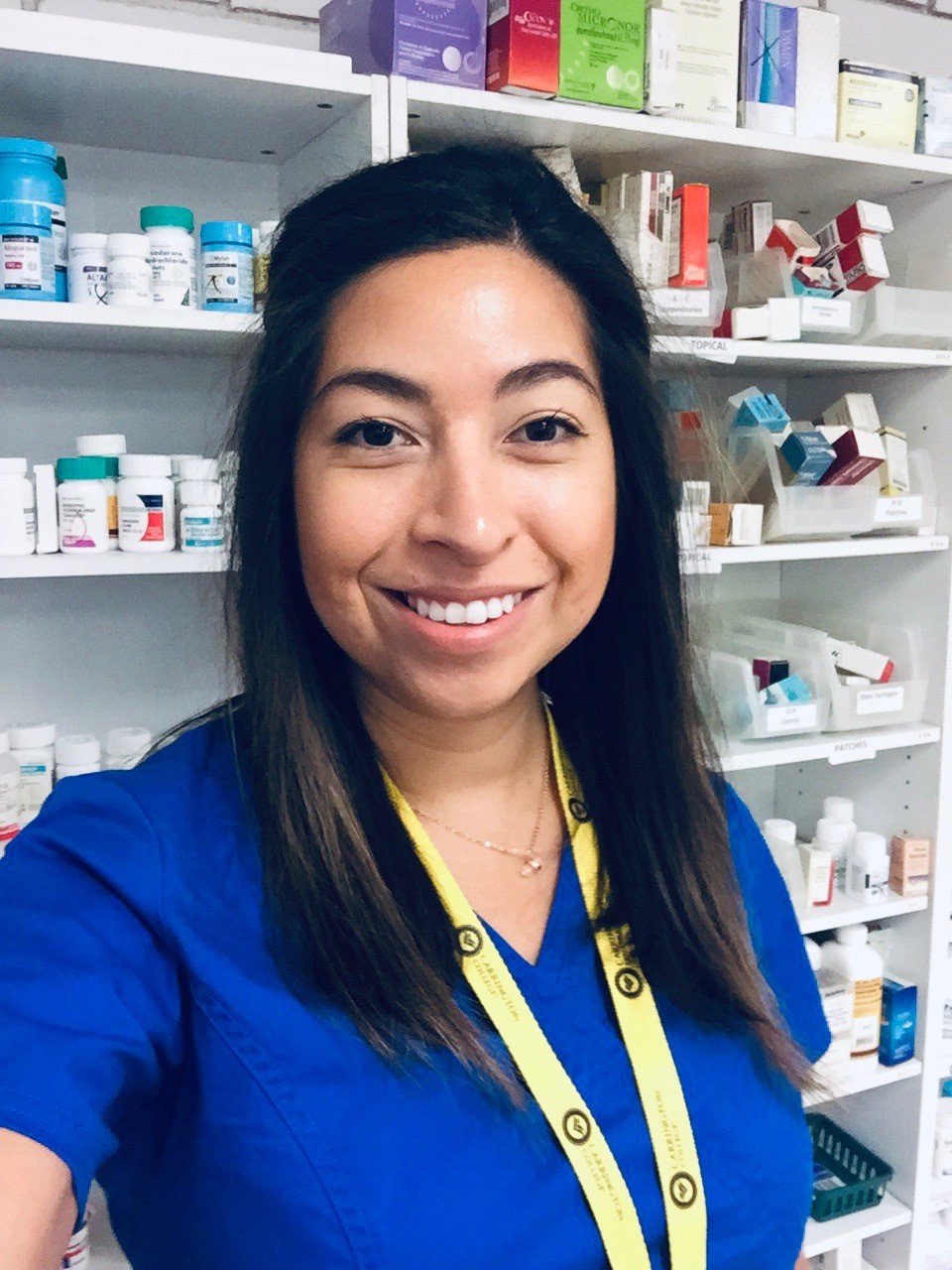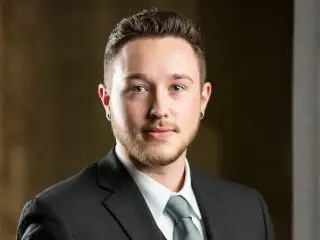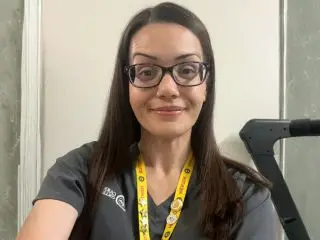 Ruth McCarty had a natural interest in pharmaceuticals and what they do long before she enrolled in the Pharmacy Technology (PT) program at Carrington Sacramento. As a wife, mother, and homecare worker for veterans, she often found herself fascinated by the information that came with prescriptions. “You know when you come home with that big packet of medications and they always have the monograph in there? How many people just never even open them? They just instantly throw them away. I’d be the one opening it up, looking at it, saying, ‘What’s it say there? What are the side effects?’ I was interested. And so when I started looking into the career field, I knew that pharmacy tech was the career that I wanted. I just knew,” she said.
Ruth McCarty had a natural interest in pharmaceuticals and what they do long before she enrolled in the Pharmacy Technology (PT) program at Carrington Sacramento. As a wife, mother, and homecare worker for veterans, she often found herself fascinated by the information that came with prescriptions. “You know when you come home with that big packet of medications and they always have the monograph in there? How many people just never even open them? They just instantly throw them away. I’d be the one opening it up, looking at it, saying, ‘What’s it say there? What are the side effects?’ I was interested. And so when I started looking into the career field, I knew that pharmacy tech was the career that I wanted. I just knew,” she said.
Not just any PT program would do, though. She had to find the right one. So, Ruth investigated schools in the Sacramento area and even did a tour of Carrington before deciding that it was the school for her.
“I really wanted to make sure it was the right choice for me. Everything was lovely and was great. I was like, ‘you know what, this is exactly what I want to do. This is where I want to be, so let’s do it,’” she said.
Her PT program started in May 2018. Ruth took morning classes that worked well with her job and responsibilities as a mom. Half the time she was in the classroom learning from Mr. Joseph De Ocampo and the other half of the time she was in the lab doing hands-on work with Mr. Elie Haddad. Each week her class had to remember twenty drug names, which included their brand names, generic names, and classifications. At the end of each six-week course, they would take a test on one-hundred different drugs. To prepare, Ruth created notecards that had the generic name on one side and the drug classification and brand name on the other side. Spelling the drugs correctly mattered, so she worked hard to memorize and get every single one of them right, which wasn’t always easy. She laughs today, “Can you imagine memorizing the spelling of Spironolactone?”
In addition to the notecards, Ruth created recordings of herself reading off the drug names and classifications, which she would listen to while driving. She was determined to use every opportunity to learn.
She said, “You should see the stack of notecards I have! I have boxes of them and that’s how I would memorize them. I would record myself. I had an hour-long commute to school in the morning, so I’d listen and hear myself say it and I’d repeat it. I’d do this every day for an hour and that adds up over six weeks. So, I was able to memorize them.”
Ruth was so focused and driven to succeed for herself and her family that when the test on one-hundred drugs came around she aced it with a score of 100%. Doing so well easily helped her maintain the tuition assistance she received as the wife of a military vet through the Dept of Veterans Administration. She also was conscientious about being punctual and never missed one day, which she says her teachers noticed and were impressed by. She attributes this to being in her mid-thirties, having more life experience, and understanding what is at stake. “I’m doing this for me. I’m doing this for my family. There’s no ‘oops, I didn’t do this project’ or ‘oops I didn’t make it.’ I’m trying to better myself and my career, so these are the steps that I need to take.”
She had insatiable curiosity when it came to learning everything she could about the drugs.
“I have learned so much! The knowledge I have now is just monumental compared to what I knew before. I’ve learned the concepts of pharmacology, pharmacokinetics, and pharmacodynamics. The different dosage formulations and the routes of administration, as well as the key terms that are spoken in the pharmacy. I also learned and came to understand the importance of medication errors. Medical terminology and abbreviations used in writing out SIGs have also been important. Then there is pharmacy law, which I now have a basic knowledge of and never knew I would need to know.”
The hands-on learning experience she got in the lab at Carrington with both sterile and non-sterile compounding was also really exciting for Ruth. Of the two different labs, she says she preferred non-sterile and went so far as to make capsaicin muscle rub for the compounding fair where students present their creations. (Capsaicin is derived from chili pepper and is known to be a mild pain reliever that works for shingles-related neuralgia, arthritic pain, or muscle sprains and strains.) She also learned along with her classmates how to fill capsules, create emollients, and make suppositories, among other critical skills. “That was a great time—we had a blast in the labs. I’d say everybody loved compounding. You get to use the tools of the trade like the mortar and pestle and learn something different.”
Ruth graduated in February 2019 and spoke for the entire graduating class at their ceremony in June of 2019, which included students from all of the different Carrington programs. By then, she had already taken her Certified Pharmacy Technician exam, passed, and become a certified PT. She’d also taken a job at Pharmerica, a self-described “post-acute and long-term care full-service pharmacy specializing in senior living settings including assisted living and skilled nursing facilities.”
After just one year at Pharmerica, Ruth is already a senior level order-entry technician. She receives prescriptions throughout the day from the more than eighty facilities that they serve. It is her job to read them (not always easy, depending on penmanship), review for issues (drug name, strength, route, frequency, day supply, etc), verify the accuracy with pharmacists, enter into the computer, build patient profiles, generate labels, and so on. She talks to nurses throughout the day, requests refills from doctor’s offices, and serves as a conduit communicating essential information that eventually helps get medication to patients so they can be healthy and comfortable.
SIG codes that describe how patients should take or administer their drugs, such as “b.i.d.” or “o.d.” for twice per day or right eye respectively, are something she uses a lot for order entry. When she graduated, her knowledge of them was limited to the more common codes, but after over a year of doing order entry, she has become fluent in even the more unusual codes. True to her ambitious and curious nature, Ruth particularly enjoys the ones that have to do with drops in the eyes because they challenge her.
She says, “The fun thing about what I do with order entry is the SIGs, which are basically the directions. I have to write out probably about two hundred SIGS a day. And that comes in from a doctors office and says things like ‘I want one drop in both eyes each night’ or ‘take one tab by mouth twice a day.’”
Her time at Pharmerica as an essential worker has been impacted by COVID19. She described when the stay-at-home order first went into effect in California and the streets were bare without another car in sight as she drove to work. The business district where she works looked like a “ghost town” with enormous vacant parking lots. Predictably, her pharmacy initially saw an uptick in requests for the drug hydroxychloroquine when it was inaccurately being touted as a COVID19 cure, but then that trend quickly died down. Now they see prescriptions for various types of inhalers and antibiotics for patients with the disease, but no one treatment is being utilized across-the-board.
Through the COVID19 crisis, as many American families have struggled and individuals have lost their jobs, Ruth has felt deep gratitude for the path she chose in 2018 and all the hard work she has put into learning pharmacy technology. It has provided her with a stable and enjoyable career that her family can count on.
She said, “I was so happy to still do my regular hours and sometimes even have to do overtime because everyone was looking to get their medications in order because they were worried we were going to shut down. I’m really glad I chose this career and chose this path because even during really difficult times, I’m still able to make good money.”
The seed of curiosity that initially led Ruth to look over prescription monographs and tour Carrington grew into something much bigger for her life. Today Ruth is a resource for her coworkers at Pharmerica—much like Mr. Haddad was a resource for her at Carrington. She is paying it forward by transforming her many strengths as an ambitious student into becoming a mentor in the pharmacy who is always ready to help others. Her light burns bright. “You need to know your units and pharmacy conversions to be a PT. I knew math but I didn’t know pharmacy conversion math. Mr. Haddad was really patient with me and he helped me learn my conversions. So, now when I’m in the pharmacy, coworkers are coming to me for help saying, ‘Ruth I can’t calculate this, can you help me calculate this?’
And I say, ‘If anybody ever wants help with their calculations, let me help you because I love it!’ It’s fun. It’s difficult. It challenges me, but I love it.”



